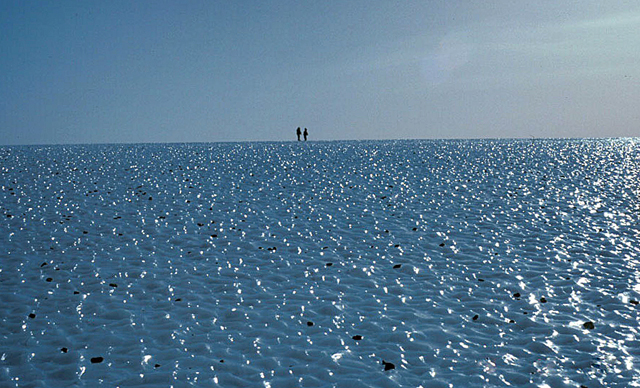Snowball EarthAntarctica natural laboratory to test hypothesis that planet was once covered in icePosted June 19, 2009
Stephen Warren “This is different,” he said. “Now we’re not trying to find out about Antarctica. We’re using Antarctica like a natural laboratory to find out about something else.” That something else concerns the ice conditions that may have existed during a time dubbed Snowball Earth, when ice and snow blanketed the planet so completely that even the ocean surface at the equator froze. It’s an intriguing and controversial hypothesis, said Warren, whose own research on the subject dates back some 30 years, even before the term Snowball Earth entered the lexicon. A term coined, incidentally, by Joe Kirschvink “It was a curiosity in climate models,” Warren explained of the Snowball Earth hypothesis that first intrigued him long ago. “It would appear in the climate models, and once you got in, it was so difficult to get out, we were sure it had never happened, because if it had happened we were sure the ice would still now be [here].” In other words, once locked into a frozen ball of ice, no one could figure out how to hit the defrost button. It was Jim Kasting Kasting pointed out in 1992 that carbon dioxide (CO2) emissions from volcanoes would build up a greenhouse effect after several million years sufficient to melt the ice. Kirschvink proposed in the same year that the snowball events actually had occurred, and Paul Hoffman of Harvard University There are other troubles with Snowball Earth. For example, it should have been traumatic for life — not only because of the extreme cold but the ice would have blocked photosynthesis — yet there’s no evidence of mass extinction. That has led some to argue that Snowball Earth is more like Slushball Earth, where severe glaciation occurred but not all the way to the equator. And certainly not with ice hundreds of meters thick on the tropical ocean. Warren said climate models dictate otherwise when one factors the effects of low latitude glaciers that today sit thousands of meters above sea level. “If you cool the climate enough to get those glaciers to come all the way down to sea level, in a climate model, then the ocean freezes.” It’s difficult, he added, to reconcile large areas of open ocean with sea-level glaciers. “The easiest conclusion is that the ocean was frozen,” he said. Hot and cold running planetSnowball Earth actually refers to a series of such extreme glaciations, the first dating back 2.2 billion years or so, about half the age of the Earth. Another series of snowball events occurred beginning about 700 million years ago, with the final event dated somewhere in the neighborhood of 570 million years ago, according to Warren. The Earth was a much different place more than half a billion years in the past. A much-younger sun emitted about 6 percent less light than today. The supercontinent Rodinia had only recently broken up, leaving a jumble of landmasses concentrated at the equator. But what appears to have sent the planet into a deep freeze was a culprit most people are familiar with in a different context. “It would have been a failure of the greenhouse effect,” Warren said. Just as today the pumping of carbon dioxide into the atmosphere is causing the Earth to warm up, the wholesale removal of the potent greenhouse gas drove temperatures downward. What soaked up all that CO2? The process probably involved something called silicate weathering, according to Snowball Earth theorists. Atmospheric CO2 forms carbonic acid rain, which over geologic time weathers and disintegrates rocks and creates soil; rivers carry bicarbonate ions into the ocean as part of the normal carbon cycle, with CO2 eventually returning to the atmosphere by volcanic emissions, Warren said. However, the weathering process can pick up speed during hot and wet periods, whether the cause of the heat is CO2 or some other greenhouse gas. Dan Schrag The planet heated up, accelerating the weathering process and the removal of CO2 from the atmosphere. Remember, most of the land sat near the equator, so it would have been susceptible to additional weathering. Meanwhile, methane has a relatively short lifespan in the atmosphere compared to carbon dioxide. Extreme cold and glaciation followed after the methane reservoir was finally exhausted and dissipated, with much of the CO2 removed from the atmosphere. And when the ice edge reached about 30 degrees latitude where solar radiation hits the tropics fairly uniformly, Warren said, “[the ice] jumps to the equator catastrophically.”1 2 Next |



For USAP Participants |
For The Public |
For Researchers and EducatorsContact UsU.S. National Science FoundationOffice of Polar Programs Geosciences Directorate 2415 Eisenhower Avenue, Suite W7100 Alexandria, VA 22314 Sign up for the NSF Office of Polar Programs newsletter and events. Feedback Form |


